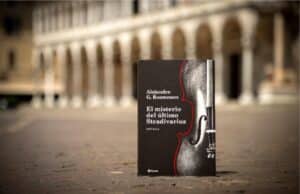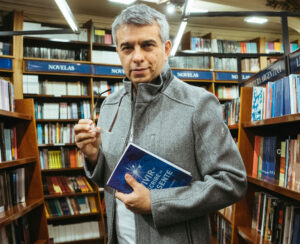- Alejandro G. Roemmers’ new novel challenges the conventions of the detective genre to delve into the supernatural.
- The plot, which begins with an unsolved double murder, revolves around a miraculous violin.
- Roemmers explores themes of love, friendship, faith, and extreme cruelty in a story that spans centuries of history.

The new novel by Alejandro G. Roemmers is full of surprises and of clues that are disconcerting, starting with their title. The mystery of the last Stradivarius It would seem to allude to a police story constructed from the “Whodunnit?” scheme: “Who did it?” However, the very word “mystery” should put us on guard against that reading. There is a subtle difference between “mystery” and “enigma”. Although the word is used inpoliceFrom enigma, “mystery” is not, like “enigma,” an intricate problem that can be solved with the tools of reason. On the contrary, it resists rational explanation and refers to a plane that transcends it.
The “mystery of the last Stradivarius” – spoiler alert! – does not refer to the clarification of the double murder that triggers the action; in reality, that specific event is never resolved, and ultimately, it doesn’t matter.The mystery lies in the violin itself, in the revealing enchantment that this prodigious object exerts.
This does not make it an amulet. Although it may seem to prolong the life of its wearers, in reality Not a few of them meet a violent end, or die in torment.Nor is it magic, in the sense that it can change the will of those who interpret or possess it. They remain free to make decisions and choose, for better or worse, their own path.
A divine language
What distinguishes the last Stradivarius is something else:speaks a divine language, puts its listeners in direct contact with a supernatural dimension.
The novel, for its part,is not intended to fit into a particular gender status. It has a mystery-packed framework, but it’s not limited to it. It has a highly developed historical dimension, but it doesn’t stop there. It’s realistic, respecting a narrative contract of verisimilitude, but, as I just pointed out, it opens up, through the violin, to a superhuman level.

But this book is also an intense adventure story, where there is no shortage of love in its various forms, enduring friendship, faith, compassion, self-denial, nor extreme cruelty and tragedy.
The starting point of the action takes place on October 22, 2021 in the city of Areguá, Paraguay, where antiquarian Johann von Bulow and his teenage daughter appear murdered The history of the violin begins almost three centuries ago in the city of Cremona.
The temporal plane of the first story (the present of the action) extends from 2021 to the almost present day and alternates in the novel with flashbacks that take us to the origins of the incomparable instrument, which, according to the fictional novel, would have been signed by the luthier Antonio Stradivari in 1737. From here on we will see how it is passing from hand to hand through different places in Europe, until falling into the clutches of Julius Heiden, a Nazi official and head of a concentration camp, who ended his days in Paraguay.
The case is entrusted to two local police officers: Commissioner Alejandro Tobosa and Sergeant Gutiérrez, whose relationship is somewhat reminiscent of that of Don Quixote (Tobosa) and Sancho Panza (the sergeant). It soon becomes clear that Gutiérrez’s roughness is not compensated, as in Sancho’s, by a loyal and kind disposition.
An object is missing
As the story progresses, the link between the bloody crime and the Stradivarius violin emerges which was presented to us readers in the second chapter: it is the only object missing from the antiquarian’s treasure.
Despite his commander’s lack of interest, as no one asks about the dead or claims their inheritance, Tobosa tenaciously continues the investigation.He has personal motivations that go beyond a genuine detective vocation and curiosity.We could say he’s fallen under the spell of beauty. The art objects representing European high culture that fill von Bulow’s storerooms dazzle him and arouse unknown emotions that reach their peak when he discovers that the criminal hasn’t been able to find the Stradivarius, still hidden in the house.
He then decides to become his savior and guardian,Even though his life is threatened by the sergeant and the commander, who intend to sell him to the highest bidder. Even knowing he’s risking everything (from his job to his own life), he’ll find a way to get him into the best hands.
Meanwhile, the alternation of times and spaces takes us to the previous adventures of the last Stradivarius in European lands This is the novel’s background, fascinating for the variety of settings, languages, atmospheres, cultures, and moments it evokes and, above all, for the effects the violin has on its listeners.
Each era and place are recreated with just the right mix of information and emotion., of intimacy and atmosphere, of historical figures in contact with fictional characters, all involved in the centuries-old intrigue of which the instrument is the axis.

From this story we enter the terrible realm of the so-called “concentration literature”, also“Holocaust literature”which, based on the direct testimony of the victims, or plausible fictionalization, evokes survival in the extermination camps.
However, there are two peculiar factors that make the difference with respect to many narratives of the genre: on the one hand (in contrast to other narratives that describe how prisoners become ruthless with others in order to survive – starting with the famous Primo Levi -), here History is woven on the bond of unbreakable solidarity which is established between two inmates: the violinist Stefanoni and the younger Ernst Bechstein, a member of a family of piano makers. This bond will last long after Stefanoni’s death, and will be decisive in leading a descendant of Bechstein to commit to the task of rescuing the violin, not just for her family, but for the salvation of humanity.
On the other hand, although stories in which certain prisoners manage to survive for a while in better conditions, thanks to special treatment by one of their captors, are not uncommon, in this novel the exception is due to a prodigious object: the last Stradivarius.
Being his interpreter allows Michele access to the protection of the music lover Heiden, which preserves the musician’s life and makes it more tolerable in some ways, although it also turns him into a sexual slave and the object of all kinds of humiliation. The final task imposed on Stefanoni is to teach his torturer and twisted benefactor how to play the violin.

Let’s return to Alejandro Tobosa, who has given up his violin in the purest gesture of self-sacrifice, despite all the risks. Demoted and exonerated from the police force, condemned to a menial job, he drags out a miserable existence, afraid that his enemies will find him and take revenge. He has lost “his positive attitude, his blind faith in the human race.”
Something like a “happy ending”
Will the novelist leave us here, accompanying Tobosa in his despair? Might there not be something like a “happy ending” for him and for the last Stradivarius?There is, and it will surely surprise readers.
But all the previous journey of the violin has shown us that one happy end can be considered definitive when it comes to human beings.Nothing guarantees that the marvelous instrument, capable of transporting listeners beyond their fallible and mortal condition, will not be stolen, trafficked, and alienated again by the agents of an evil that always returns.
On the other hand, if the violin does not lose its magic, even if its performer is a true moral monster, like Heiden, it is also true that it does not, in and of itself, alter the condition of its bearers.If the instrument transmits a divine call that reaches the hearts of all beings, not everyone wants to assent to it.Heiden may be able to convey the message to others, but he won’t accept it. By his own choice, he will die unrepentant, alone, and hated.
On the tortuous path of History, despite the failures or aberrant crimes of its eventual interpreters,The music of the Stradivarius opens mystical bridges towards communion with the absolute,where everything seems to make sense, even the darkness, even what we cannot understand from our limited humanity.
Perhaps for this reason, the best way to close are the words of Saint Augustine that the other Alexander, Roemmers, puts in the mouth of Sister Felicitas: “Because just as a painting, when the color black is placed in its proper place, is beautiful,So the world, if one could see it, even with the same sinners, is beautiful.”.
Thus, human art, that of the luthier, that of music, and that of the performer, can align in a dazzling illumination that, when heeded, leads to the mystery of Being, consoles, and saves.
The mystery of the last Stradivarius, by Alejandro Roemmers (Planeta).
By María Rosa Lojo








